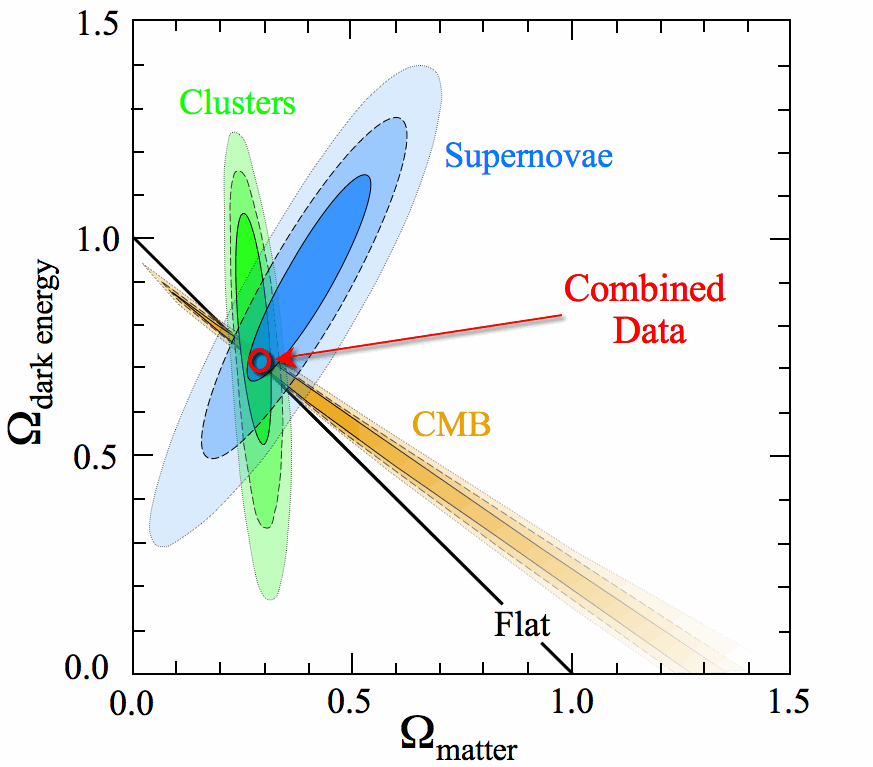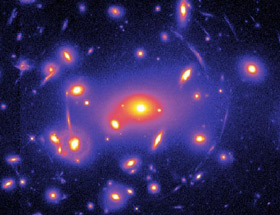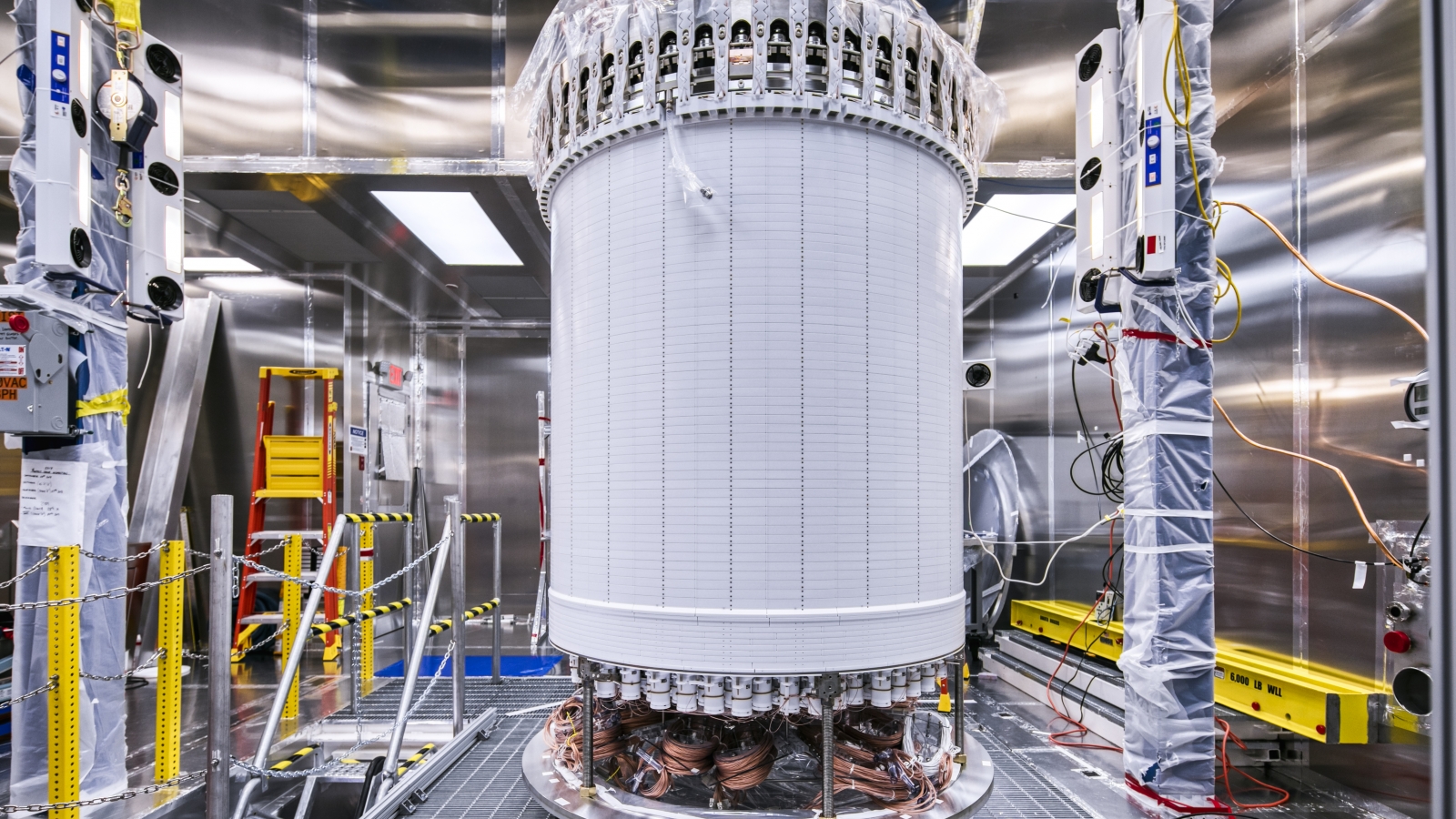Dark Matter
Precise cosmological measurements coupled with astronomical evidence has allowed us to piece together a model of the Universe that explains much of what we observe. This model is known as the ΛCDM model and tells us that we live in an inflationary universe that is made up of contributions from 'dark energy' (68%), responsible for the accelerating expansion of the Universe, baryonic 'normal' matter (5%), and a 'dark matter' component, which makes up the remaining 27%. However, the nature of the dark elements remains unknown and consequently, fundamental questions still cloud the model. From both astrophysical and particle physics considerations, stable and heavy Weakly Interacting Massive Particle (WIMP) candidates that arise naturally from extensions to the Standard Model of particle physics are particularly compelling.


WIMPs, interacting with regular matter only very rarely, would satisfy the requisite abundance today, be stable on the timescales of the Universe, and would have been non-relativistic at the time of decoupling - providing the gravitational seeds for large scale structure formation. Its presence today acts as the glue holding galaxies such as our own together. Confirmation of the WIMP hypothesis would cast light not only on Beyond Standard Model physics and extrapolation to GUT scales, but would considerably advance our understanding of the matter composition and evolution of the Universe. For these reasons, the discovery of Dark Matter has been identified as among the most important scientific missions of the 21st century.
Three avenues are presently pursued with the aim to identify dark matter: indirect, accelerator, and direct searches. Indirect methods deploy space-based and terrestrial instruments to search for signals from decay products following WIMP annihilations in regions of high density. Accelerator searches such as at the LHC seek to achieve sufficient collision energies to be able to produce WIMPs and observe missing reconstructed energy in the final states to infer their mass. However, neither of these techniques is by itself capable of providing a robust statement on the nature of dark matter. Expected annihilation signatures from indirect searches are easily mimicked by standard sources, and accelerator searches cannot address stability of the inferred particles and conclude that they represent galactic WIMPs. Instead, it is direct observation of WIMPs within our own Milky Way that is recognised as the definitive channel for detection. Internationally, meeting this challenge and detecting galactic WIMPs is recognised as one of the highest priorities in science, featuring often above all else in roadmaps and research recommendations worldwide.
Direct Dark Matter Searches
Galactic rotation curves suggest the dark matter forms an extended halo around galaxies such that our solar system, moving through this halo, is exposed to an apparent flux of WIMPs. These WIMPs may be directly detected by recording the energy deposition made by a recoiling nucleus following a WIMP scatter. However, given the kinematics, the recoil would generate energies of only a few keV. Moreover, the event rate is dictated by the coupling of a dark matter particle through the Weak force, resulting in extremely rare signals. Experiments must, therefore, operate detectors with very low thresholds, very low intrinsic and external radiological background, located in deep underground sites shielded from cosmic rays. Despite these challenges, several technologies have been developed and deployed successfully over the past 30 years in attempts to be the first to discover WIMPs. Where no signal has been detected, constraints on the WIMP-nucleon interaction cross-section have been derived. As yet, no unambiguous discovery of dark matter has been made.


Here at UCL, we work on world leading and cutting-edge experiments in the search for dark matter. Our main focus is on LUX-ZEPLIN (LZ), a WIMP search experiment which uses the same two-phase liquid xenon time projection chamber design employed by its predecessor, LUX. With 350 kg of ultra-pure liquid xenon, LUX was able to set a series of world leading results in the search for WIMPs between 2013 and 2019. LZ brings together the LUX project and ZEPLIN programme, which pioneered the use of xenon time projection chamber technology through a series of xenon detectors at the Boulby Underground Laboratory. Compared to LUX, LZ is a mammoth detector containing 10 tonnes of liquid xenon, with 7 tonnes in the active volume. Like LUX, LZ is hosted at the Sanford Underground Research Facility (SURF) in South Dakota, USA, and is housed using the same infrastructure. As of 2025, LZ has twice set world leading upper limits on spin-independent scattering cross-sections between nucleons and WIMPs with masses greater than 9 GeV/c2 (LZ 2022, LZ 2024), and leads all other experiments by a wide margin. The experiment is continuing to acquire data with plans to operate until 2028, in pursuit of a final exposure of 1000 live days.
UCL has been and continues to be a major contributor to LZ's unparalleled search capability for galactic dark matter. During construction, we held co-responsibilty for the crucial Backgrounds and Screening Work Package, which ensured the experiment met its low-background requirements for the detection of WIMP Dark Matter, and built the high-precison Background Model against which any possible WIMP signal is now evaluated. We utilised cutting-edge radio-purity assay facilities to screen all potential construction materials for trace amounts of radio-impurities, which included our dedicated ICP-MS laboratory at UCL (since relocated to Boulby Underground Laboratory). UCL also held major responsibilities in commissioning the experiment, preparing for data taking, as well as developing machinery for statistical inference and Monte Carlo simulations. Since completion of the construction and commissioning of the detector, UCL has become a pivotal institution within the LZ collaboration in driving scientific output. Within our group are research staff and students that contribute to data quality, simulations, low energy calibrations, background mitigation, and background modelling. Additionally, we employ leaders in both low & high energy signal searches, as well as statistical inference.


In addition to working on LZ, we are also a central institution in XLZD: a merger of the XENON, LZ, and DARWIN collaborations for a 'Generation-3' (G3) dark matter search experiment. XLZD will also be a multi-tonne liquid xenon time projection chamber, about 6-8 times bigger in target mass than LZ (see the XLZD design book). UCL is responsible for the Clean Manufacture Work Package, which will oversee the assembly of detector components in ultra-clean conditions in the lab. XLZD will have unprecedented sensitivity to the standard WIMP hypothesis, with projected sensitivity to WIMP parameter space all the way down to the neutrino fog. XLZD will also search for previously inaccessible but theoretically well-motivated alternative (non-WIMP) thermal relic Dark Matter candidates, and probe Beyond the Standard Model physics that no other techniques can reach.
Finally, we are exploring the use of novel quantum technologies to broaden the search for dark matter. Using opto-mechanically levitated nano-spheres and superconducting wires we are working with colleagues in UCL's AMOPP group and the Cosmoparticle Initiative to develop the technologies to search for ultra-light Dark Matter candidates, complementing the large underground searches for higher mass particle dark matter with LZ and future G3.

